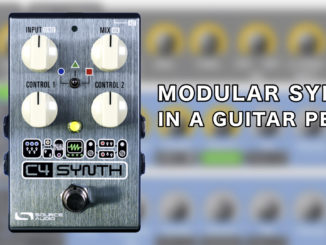Meris Enzo X, the Enzo successor, is a new stereo pedal that turns your guitar into a powerful polyphonic Synthesizer with no extra hardware.
Synthesizers come in many different forms. We know them mainly on keyboards, desktops, or modular formats. Synthesizers can also be found in the guitar world, mostly in pedals. In order to make this possible, guitars used to have to be equipped with extra pickups.
Thanks to ever-improving algorithms, this is a thing of the past. One that does this great is the yellow Meris Enzo pedal from 2018. Now the Meris developers have taken this to a new level with the Enzo X.
Meris Enzo X
Enzo X is a new stereo pedal that uses a modular instrument Synthesizer architecture powered by an advanced ARM processor.
Like the original Enzo, the new Meris Enzo X uses a polyphonic pitch detection algorithm with no special pickup necessary. This is a great advantage compared to previous synth pedal technologies. So you can quickly and without detour transform any guitar into a Synthesizer instrument.
The synth engine is digital, has six fully polyphonic voices, and can be played with a guitar instrument signal or a traditional MIDI keyboard. There are five distinct synth modes: mono, polyphonic, arp, and dry processing modes.
According to the DSP engineer Angelo Mazzocoo, the arp mode has been redone for the Enzo X version and offers more parameters, giving you more flexibility, including directions, step number, and more.
Enzo X Synth Engine
Each Enzo X voice features a classic subtractive synthesis architecture. It starts with a set of two oscillators with selectable saw, triangle, and square waveforms and cross-modulation for FM textures. Unfortunately, the oscillators do not have PWM, which would be a shame.
Then, you can choose between the original ladder and state-variable filters and the new twin filter to shape the oscillator signals. The twin filter is a new design and features two parallel filters with an offset control. Also new is the option to inject noise into the filter and a dedicated envelope control.
To refine or push your sounds further, you get three reverbs (Prism algorithm) from the Mercury X, five overdrives (three pre-amps, panning volume, bit-crusher), a 2.5-second stereo delay, and five modulation types (chorus, vibrato, multimode flanger, ring mod, and 24-stage flanger).
So, you get a multi-FX processor on top of the synth engine. Modulation is also onboard. You can find two ADSR envelopes for the amplitude and filter.
The new modifier section supercharges this first set of modulators with options and gives more options to animate parameters. You can work with two LFOs, another envelope generator, S&H, a hold modifier, and a sequencer.
Settings can be saved in 99 preset locations in 33 banks. The system also hosts a favorite preset bank that gives you instant access to your three favorite presets. Indeed, the synth engine has become much more feature-rich on the Meris Enzo X than on the original Enzo. Also, the interface has more on offer.
The new Enzo X pedal has a wider user interface with more hardware controls: pitch, filter, level, mod, and more.
It also houses a new OLED display with dedicated encoders for guiding through the easy-to-use bubbly user interface adapted from the Mercury X stereo reverb and LVX modular delay. Plus, you get four switches.
Other features are full MIDI implementation with MIDI CC, beat clock synchronization and more.
Connectivity
On the backside, you get stereo in/out connectivity on L/R mono jacks for true stereo processing, an expression pedal jack, 5-pin DIN MIDI in/out, USB-C for firmware updates, and a 9VDC center-negative power supply socket.
First Impression
This is a great further development of the original Enzo pedal. I like the added feature set and the user interface. Looks like a neat overall package of synthesis and multi-FX. From a synth head perspective, the virtual analog engine is certainly a bit underwhelming, but for guitarists, it is certainly an exciting sound design tool.
Meris Enzo X is available now for $599.
More information here: Meris




Be the first to comment